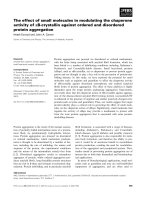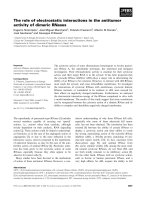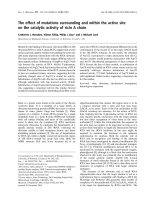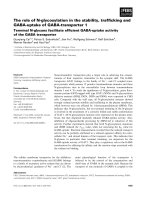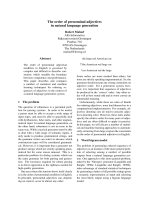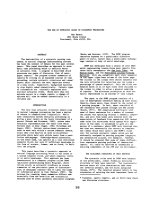Báo cáo khoa học: " The effect of methyl sulphonyl methane supplementation on biomarkers of oxidative stress in sport horses following jumping exercise" doc
Bạn đang xem bản rút gọn của tài liệu. Xem và tải ngay bản đầy đủ của tài liệu tại đây (277.72 KB, 9 trang )
BioMed Central
Page 1 of 9
(page number not for citation purposes)
Acta Veterinaria Scandinavica
Open Access
Research
The effect of methyl sulphonyl methane supplementation on
biomarkers of oxidative stress in sport horses following jumping
exercise
Gonzalo Marañón
1
, Bárbara Muñoz-Escassi
1
, William Manley
1
, Cruz García
2
,
Patricia Cayado
1
, Mercedes Sánchez de la Muela
3
, Begoña Olábarri
1
,
Rosa León
1
and Elena Vara*
2
Address:
1
Horsepital SL. Madrid, Spain,
2
Departamento de Bioquímica y Biología Molecular. Facultad de Medicina. Universidad Complutense de
Madrid. Madrid, Spain and
3
Departamento de Medicina Animal y Cirugía. Facultad de Veterinaria. Universidad Complutense de Madrid. Madrid,
Spain
Email: Gonzalo Marañón - ; Bárbara Muñoz-Escassi - ;
William Manley - ; Cruz García - ; Patricia Cayado - ;
Mercedes Sánchez de la Muela - ; Begoña Olábarri - ; Rosa León - ;
Elena Vara* -
* Corresponding author
Abstract
Background: Exercise induces changes in several organs and tissues, and this process might be due to
oxidative damage caused by free radicals and inflammatory mediators. Methyl Sulphonyl Methane, better
known as MSM, is a naturally occurring sulphur compound with well-known antioxidant properties. On
the other hand, Vitamin C is important in limiting free radical damage in the aqueous phase of the cell, and
cellular vitamin C status may be linked to the mechanisms involved in quenching cellular reactive oxygen
species. The aim of this study was to determine if supplementation with MSM and vitamin C could alleviate
exercise-induced oxidative stress in horses undergoing jumping competition.
Methods: Twenty four jumping horses involved in competition were used. Horses were given the
following three treatment diets: control (without supplementation), MSM 8 mg/kg, and combined
supplements (MSM 8 mg/kg + Vit-C 5 mg/kg). EDTA blood samples were collected before exercise, upon
arrived to the schooling area (control), and each week after last show. Nitric oxide, carbon monoxide,
lipid hydroperoxides and the antioxidant enzymes, glutathione peroxidase, glutathione transferase and
glutathione reductase, plasma levels were determined.
Results: Competition induced a significant increase in lipid peroxidation, nitric oxide and carbon
monoxide. By contrary, reduced glutathione as well as antioxidant enzyme activities, were decreased. MSM
administration significantly ameliorated all these exercise-related changes, and this effect was potentiated
by Vit C reaching values in some of the parameters similar to those found before competition.
Conclusion: These results suggest that jumping exercise could induce harmful effects on horses, probably
due to an increase in oxidative damage and proinflammatory molecules. In addition, we have demonstrated
that MSM could exert some protective effect on oxidative and inflammatory exercise-induced injury.
Published: 7 November 2008
Acta Veterinaria Scandinavica 2008, 50:45 doi:10.1186/1751-0147-50-45
Received: 8 November 2007
Accepted: 7 November 2008
This article is available from: />© 2008 Marañón et al; licensee BioMed Central Ltd.
This is an Open Access article distributed under the terms of the Creative Commons Attribution License ( />),
which permits unrestricted use, distribution, and reproduction in any medium, provided the original work is properly cited.
Acta Veterinaria Scandinavica 2008, 50:45 />Page 2 of 9
(page number not for citation purposes)
Background
Exercise is accompanied by several changes in the mor-
phology and physiology of different organs and tissues.
One of the theories that tries to explain the exercise effects
defends that it may be in part due to the accumulation of
oxidative damage induced by reactive oxygen species
(ROS) and reactive nitrogen species (RNS) to cells and
macromolecules [1-3]. ROS are highly reactive molecules
which are mainly generated in mitochondria during oxy-
gen metabolism [4]. Approximately 95% of the oxygen
consumed is reduced to water during aerobic metabolism,
but the remaining fraction may be converted to reactive
oxygen species and other free radicals, inducing oxidative
stress. There may be a number of sources of this oxidative
stress, including mitochondrial superoxide production,
ischemia-reperfusion mechanisms and auto-oxidation of
catecholamines. Severe or prolonged exercise can over-
whelm antioxidant defences, which include vitamins E
and C and thiol antioxidants, which are interlinked in an
antioxidant network, as well as antioxidant enzymes. Evi-
dence for oxidative stress and damage during exercise
comes from direct measurement of free radicals, from
measurement of damage to lipids and DNA, and from
measurement of antioxidant redox status, especially glu-
tathione. There is little evidence that antioxidant supple-
mentation can improve performance, but a large body of
work suggests that bolstering antioxidant defences may
ameliorate exercise-induced damage.
On the other hand, strenuous and/or damaging exercise
elicits a stress response analogous to the acute-phase
immune response. Exercise-induced tissue damage and/or
increased reactive oxygen species production stimulate
cytokine production, up regulating the inflammatory cas-
cade [5]. Two molecules that have been recently involved
in oxidative damage and inflammatory response are Nitric
oxide (NO) and Carbon monoxide (CO). Nitric oxide can
act as both inflammatory mediator and RNS, either
directly or through peroxynitrites generated by its interac-
tion with O
2
-
[6,7]. CO is one of the elements of the
Hemo-oxygenase 1-CO pathway, which has been pro-
posed to constitute a defence system against oxidative and
inflammatory damage [8]. Both NO and CO activate sol-
uble-guanilyl cyclase (sGC), thus inducing and increase in
intracellular cyclic-guanilyl monophosphate (cGMP) as
second messenger [8,9].
Vitamin C (ascorbic acid) is a powerful natural antioxi-
dants in mammals [10]. It is present in high concentra-
tions in leukocytes and there is evidence that it is involved
quenching cellular reactive oxygen species. However,
results from previous studies examining the effects of sup-
plementation with Vitamin C exercise-stimulated oxida-
tive damage have been inconclusive: inhibition of lipid
peroxidation [11], no effect [12], and even increased lipid
peroxidation [13]. Possible reasons for these inconsisten-
cies include differences in modes, duration, and intensity
of exercise.
On the other hand, Methyl Sulphonyl Methane, better
known as MSM, is a naturally occurring sulphur com-
pound that MSM may plays a role in the synthesis of glu-
tathione (GSH) [14] one of the most important
intracellular antioxidants [15], through its transulfuration
pathway [14].
MSM has demonstrated to exert protective effects against
many diseases in humans, such as hyperacidity, parasites,
constipation, musculoskeletal pain, arthritis, allergies and
immunomodulation [16-18]. However, to our knowledge
little is known about the mechanism by which MSM may
exert its protective effect against exercise-induced oxida-
tive stress in horses.
The purpose of the present study was to determine
whether exercise-induced oxidative stress responses could
be alleviated by supplementation with MSM and vitamin
C in horses undergoing jumping competition.
For this purpose, NO, CO lipid hydroperoxides (LPO),
glutathione plasma levels were determined after intensive
jumping competition in horses. Additionally, we also
determined plasma antioxidant enzyme (glutathione per-
oxidase, glutathione transferase and glutathione reduct-
ase) activities.
Methods
Twenty for jumping horses (8–13 years old; 2 stallions, 13
geldings, 9 mares) competing in the south of Spain (Win-
ter Sunshine Tour) during 5 weeks (3–4 days/week), were
used in the present study. All horses were apparently
healthy and showed a good performance condition,
Horses were randomly assigned to one of three experi-
mental groups: MSM group (8 mg/Kg of MSM, Alefa
Aesar, Germany: 98–99% purity, daily); MSM+Vit C
group (8 mg/Kg of MSM plus 5 mg/Kg of vitamin C, daily)
and Control (no supplementation). Supplements (one
daily oral dose mixed in the morning feed), were admin-
istered in spaced doses, 7 days before arrived to the
schooling area and every day until the end.
Weight average (540 ± 47 Kg), estimated by standardized
measuring tape around the thorax, and was similar in all
groups.
Blood samples were collected from the jugular vein of
each horse. The first sample was collected one day after
arrival to the show ground (in the morning, 90 minutes
after feeding and before exercise). All the other samples
were collected 10–15 minutes after competition, at
Acta Veterinaria Scandinavica 2008, 50:45 />Page 3 of 9
(page number not for citation purposes)
weekly intervals (all horses were warmed up for 20–30
minutes and then jumped over a course of 500 meters
with 16 jumps at an average speed of approximately 350–
400 meters/minute).
Blood was drawn into 5 cc purple-top Vacutainer tubes
(containing 1 mg/mL EDTA). Blood was centrifuged in a
standard centrifuge (Labofuge 300, Heraeus Holding,
Germany) at 3000 g × 10 min; plasma was then aliquoted
for various assays and stored at -80°C until day of analy-
sis.
The research project was approved by our institution
(Universidad Complutense de Madrid) and by the "Real
Federación Hípica Española". Prior to initiation the study,
an informed consent was provided by horse's riders, as
well as by the owners.
For GSH assessment, a specific colorimetric method was
used [19]. Briefly, glutathione was sequentially oxidized
by 5-5' dithio-bis (2-dinitrobenzoic acid) (DTNB) and
reduced by NADPH in the presence of glutathione
disulfide reductase, which results in the formation of 5-
thio-2-nitrobenzoic acid (TNB). The rate of TNB forma-
tion is measured spectrophotometrically at 412 nm.
Plasma levels of LPO and GPx, GST and GR activities were
measured by commercially available kits (Cayman Chem-
ical Company, Ann Arbor, USA).
NO plasma concentration was measured by the Griess
reaction as NO
2
concentration after NO
3
reduction to NO
2
as currently performed in our laboratory [20]. Briefly,
samples were deproteinized by the addition of sulfosali-
cylic acid, were then incubated for 30 min at 4°C, and
subsequently centrifuged for 20 minutes at 12,000 g. After
incubation of the supernatants with Escherichia coli NO
3
reductase (37°, 30 min), 1 ml of Griess reagent (0.5%
naphthylenediamine dihydrochloride, 5% sulfonilamide,
25% H
3
PO
4
) was added. The reaction was performed at
22 °C for 20 min, and the absorbance at 546 nm was
measured, using NaNO
2
solution as standard. The meas-
ured signal is linear from 1 to 150 μM (r = 0.994, P <
0.001, n = 5), and the detection threshold is ~2 μM.
To quantify the amount of CO, the ratio of carboxy-hae-
moglobin after haemoglobin addition was measured
[21]. Haemoglobin (4 μM) was added to samples and the
mixture was allowed to react for 1 min, to be sure of a
maximum binding of CO to haemoglobin. Then, samples
were diluted with a solution containing phosphate buffer
(0.01 mol/L monobasic potassium phosphate/dibasic
potassium phosphate, pH 6.85) containing sodium
dithionite, and after 10 min at room temperature, absorb-
ance was measured at 420 and 432 nm against a matched
curve containing only buffer [21].
Reproducibility within the assays was evaluated in three
independent experiments. Each assay was carried out with
three replicates. The overall intra-assay coefficient of vari-
ation has been calculated to be <5%. Assay to assay repro-
ducibility was evaluated in three independent
experiments. The overall inter-assay coefficient of varia-
tion has been calculated to be <6%.
Statistical analysis
Results are expressed as the mean ± SEM, from n = 8. Mean
comparison was done by the Kuskal-Wallis test followed
by a Mann Whitney test; a confidence level of 95% (p <
0.05) was considered significant.
Results
As shown in figure 1, exercise decreased all antioxidant
enzymes studied. GR activity was reduced by exercise in a
time-dependent manner, while no changes were observed
in GPx and GST activities during time. These effects were
partially prevented by MSM, although levels remain lower
than those observed on week 0, before starting competi-
tion. When MSM was combined with Vit C, the three
enzymatic activities were restored reaching normal values
(before starting competition).
Exercise resulted in a dramatic decrease in GSH plasma
levels (Fig. 2), while mean plasma oxidized glutathione
(GSSG) did not significantly change suggesting that GSH
may play a central antioxidant role in plasma during
intensive physical exercise and that its modifications are
closely related to exercise intensity. MSM induced an
increase in GSH levels, and again the MSM effect was
potentiated by Vit C, reaching values comparable to those
observed before exercise.
LPO content was higher after exercise as compared to
those before exercise, (Fig 3). When animals were supple-
mented with MSM or MSM+Vit C, a reduction in LPO con-
tent was observed.
As shown in the figure 4A, exercise also induced an
increase in CO plasma levels of horses after exercise.
When MSM, alone or in combination with Vit C, was
administered, a reduction in CO release was found.
NO plasma level was increased with exercise (Fig 4B).
When horses were supplemented with MSM, no signifi-
cant effect was observed during the first days, but it
reduced the increase in NO levels after intensive exercise
(several weeks competing).
Acta Veterinaria Scandinavica 2008, 50:45 />Page 4 of 9
(page number not for citation purposes)
Effect of methyl sulphonyl methane (MSM), alone or combined with vitamin C (Vit C), on training-induced decrease of glutath-ione peroxidase (GPx), glutathione transferase (GST) and glutathione reductase (GR) activitiesFigure 1
Effect of methyl sulphonyl methane (MSM), alone or combined with vitamin C (Vit C), on training-induced
decrease of glutathione peroxidase (GPx), glutathione transferase (GST) and glutathione reductase (GR)
activities. Values are expressed as mean ± SEM.
Acta Veterinaria Scandinavica 2008, 50:45 />Page 5 of 9
(page number not for citation purposes)
Discussion
The role of ROS in the exercise-induced damage is sup-
ported by many studies. ROS production has been found
to increase with exercise, thus augmenting the amount of
oxidative damage induced to lipids, proteins and DNA
[1,2,22,23]. The control of ROS is important to the athlete
because they interfere with the rebuilding process which is
so necessary after strenuous competition. Therefore, many
studies have focused their attention on the search of sub-
stances that could restrain this increase in exercise-
induced oxidative stress.
Vitamin C and MSM are known antioxidants which can
scavenge ROS, thus preventing tissue damage. MSM, an
endogenous cellular metabolite that acts as sulphur donor
in many transmethylation reactions, is also able to act as
an antioxidant and free radical scavenger. It has also
shown to exert protective effects on different experimental
pathological situations, in which free radicals and ROS are
involved, such as hyperacidity, parasites, constipation,
musculoskeletal pain, arthritis, allergies, Ehlers-Dantos
syndrome and immunomodulation [16,17,24]. Thus, it
seemed interesting to look into the possible protective
effect of this molecule on the effects of strenuous exercise,
in which free radicals seem to be involved.
A decrease in GSH-related enzyme activities after exercise
has been found in this study. This finding is in accordance
with previous studies, in which a decrease of these activi-
ties was observed [25-27]. However, to our knowledge
this is the first work showing a decrease in GSH-related
enzymes after jumping competition. This reduction in
Effect of methyl sulphonyl methane (MSM), alone or combined with vitamin C (Vit C), on training -induced decrease of reduced glutathione (GSH) plasma levelsFigure 2
Effect of methyl sulphonyl methane (MSM), alone or combined with vitamin C (Vit C), on training -induced
decrease of reduced glutathione (GSH) plasma levels. Values are expressed as mean ± SEM.
Acta Veterinaria Scandinavica 2008, 50:45 />Page 6 of 9
(page number not for citation purposes)
GPx and GST activities would lead to a decrease in GSH
synthesis, which would affect many essential metabolic
pathways in which GSH is involved.
The glutathione (GSH) antioxidant system is foremost
among the cellular protective mechanisms. Depletion of
this small molecule is a common consequence of
increased formation of reactive oxygen species during
increased cellular activities. This phenomenon may occur
in the lymphocytes during the development of an
immune response or in muscular cells during strenuous
exercise. Oxidative stress could be involved in this exer-
cise-related decrease in enzyme activities. This situation
would lead to a self-perpetuating cycle, in which the free
radicals generated would induce GSH depletion, thus
increasing oxidative stress that would reduce antioxidant
enzyme levels, which would further reduce GSH synthe-
sis. Exhaustive exercise depletes glutathione and simulta-
neously generates free radicals. This is evidenced by
increases in lipid peroxidation, glutathione oxidation,
and oxidative protein damage [28]. In our study exercise
induced an increase in cellular oxidative stress (as shown
by the increase in LPO content) and NO levels, and these
factors could account for the increase in oxidative stress.
A reduction in GSH levels was also found, which could be
both, cause or consequence of the decrease in GPx and GR
activities. Supplementation to the horses with MSM was
able to provoke a recovery of GPx and GR activities, pre-
sumably due to a reduction in oxidative and inflamma-
tory damage induced by the improvement of GSH, and
NO levels, as will be discussed later.
Effect of methyl sulphonyl methane (MSM), alone or combined with vitamin C (Vit C), on training -induced increase of lipid hydroperoxides (LPO) levelsFigure 3
Effect of methyl sulphonyl methane (MSM), alone or combined with vitamin C (Vit C), on training -induced
increase of lipid hydroperoxides (LPO) levels. Values are expressed as mean ± SEM.
Acta Veterinaria Scandinavica 2008, 50:45 />Page 7 of 9
(page number not for citation purposes)
Effect of methyl sulphonyl methane (MSM), alone or combined with vitamin C (Vit C), on training -induced changes on carbon monoxide (CO) and nitric oxide (NO) plasma levelsFigure 4
Effect of methyl sulphonyl methane (MSM), alone or combined with vitamin C (Vit C), on training -induced
changes on carbon monoxide (CO) and nitric oxide (NO) plasma levels. Values are expressed as mean ± SEM.
Acta Veterinaria Scandinavica 2008, 50:45 />Page 8 of 9
(page number not for citation purposes)
GSH is the most important intracellular antioxidant thiol,
and the liver is its main source [15]. It has been shown
that exercise induces perturbations in blood glutathione
redox status [22,29-31] and these reports are in accord-
ance with our present findings. This fact could be either
cause or consequence of the increase in oxidative damage
found after exercise. In our study, supplementation with
MSM induced an increase in GSH levels, as could be
expected, since MSM metabolism provides one of the pre-
cursors needed for GSH synthesis, therefore counteracting
GSH depletion.
As it has been previously mentioned, free radicals have
been implicated as mediators on exercise-induced cellular
dysfunction and cell to cell signalling. On the other hand,
it is known that mitochondrial production of oxygen-
derived radicals is increased with exercise [4], and this fact
could be a major mechanism for the exercise-related
increase in oxidative stress. Our finding of increased
horse's plasma LPO content after jumping exercise sup-
ports the hypothesis of augmented oxidative stress with
exercise. The exercise-induced increase in LPO content
was reverted by supplementation with MSM, pointing to
an improvement in the oxidative status of the cells,
according to the MSM-induced increase of GSH previ-
ously mentioned. Moreover, MSM has been suggested to
act as a direct free radical scavenger, a mechanism that
could also be involved in its antioxidant properties [14].
Vitamin C is an important water soluble vitamin. As an
antioxidant, vitamin C's primary role is to neutralize free
radicals. It is in a unique position to scavenge aqueous
peroxyl radicals before these destructive substances have a
chance to damage the lipids [32]. It works along with vita-
min E, a fat-soluble antioxidant, and the enzyme glutath-
ione peroxidase in order to stop free radical chain
reactions. Once vitamin C is depleted, uric acid, albumin
bound bilirubin and protein thiols only partially reduce
lipid peroxidation [32]. The effect of Vitamin C on exer-
cise-stimulated oxidative damage remains controversial
[11-13]. In this study we found that the protective effect of
MSM against exercise-induced oxidative stress was
enhanced by vitamin C. Although our data do not provide
a clear explanation about the mechanisms by which vita-
min C potentiated the effect of MSM, they suggest that
MSM, and vitamin C have common targets or work syner-
gistically to protect cells from oxidative damage.
Some exercise-related pathologies are now considered
chronic inflammatory processes. In fact, proinflammatory
molecules have been reported to increase with strenuous
exercise [33]. Nitric Oxide (NO) is one molecular media-
tor involved in both the inflammatory response [34] and
oxidative damage [6,35]. In the present study, NO plasma
levels were found to be increased after exercise, in accord-
ance with other reports, which show that iNOS activity
and NO release are increased with exercise in several tis-
sues [36,37]. Our study shows that supplementation with
MSM did not modify the increase in NO plasma levels
observed after the first day of competition, but is able to
reduce the increase in NO levels after intensive exercise
(several days competing), suggesting that this molecule
may be able to modulate the inflammatory response.
CO is a physiologically synthesized molecule that shares
some of the mechanisms of action and physiological
effects of NO [8,9]. The main endogenous source of CO is
heme metabolism by heme-oxygenase (HO) [8,9]. This
HO-CO pathway has been recently proposed to be
involved in the defence against oxidative stress and the
deleterious effects of NO, since it removes the cytotoxic
free heme, and produces some molecules with antioxi-
dant and anti-inflammatory effects, such as biliverdin and
CO [8,38-40]. Therefore, this pathway could be activated
to counteract an excess of oxidant and inflammatory
agents [8]. The present study shows that exercise induces
an increase in plasma CO levels, and this could mean that
this defence mechanism has been activated by the increase
in exercise-associated ROS and proinflammatory mole-
cules, such as NO. We also demonstrate that MSM is able
to reduce CO release, and this could be due to the fact that
horses supplemented with MSM are exposed to a lesser
amount of ROS and RNS, therefore leading to a lower HO
induction.
Conclusion
These results suggest that jumping exercise could induce
harmful effects on horses, probably due to an increase in
oxidative damage and proinflammatory molecules. In
addition, we have demonstrated that MSM could exert
some protective effect on oxidative and inflammatory
exercise-induced injury. All these findings suggest the
necessity of investigating the mechanisms of the protec-
tive effect of MSM, in order to develop strategies capable
to increase performance in sport horses.
Abbreviations
MSM: methyl sulphonyl methane; Vit C: vitamin C; GPx:
glutathione peroxidise; GST: glutathione transferase; GR:
glutathione reductase; HO: heme oxygenase; ROS: reac-
tive oxygen species; RNS: reactive nitrogen species; NO:
nitric oxide; CO: carbon monoxide; GSH: glutathione.
Competing interests
The authors declare that they have no competing interests.
Authors' contributions
GM: Participated in the design of the study and performed
the statistical analysis. BME, WM, MSM, PC, BO, RL and
CG: Participated in the recovery of blood samples and car-
Acta Veterinaria Scandinavica 2008, 50:45 />Page 9 of 9
(page number not for citation purposes)
ried out the biochemistry determinations. EV: Conceived
the study, participated in its design and coordination and
helped to draft the manuscript. All authors read and
approved the final manuscript.
Acknowledgements
We would like to express our sincere thanks to the Real Federación Hípica
Española and the Spanish riders for their kind cooperation.
We are especially grateful to Rutherford Latham and Alfonso Arango
(Jumping riders) for excellent collaborations and discussions.
We also thank Ana García-Quiralte and Babette Mc Cafee for technical
assistance.
References
1. Selamoglu S, Turgay F, Kayatekin BM, Gonenc S, Islegen C: Aerobic
and anaerobic training effects on the antioxidants enzymes
of the blood. Acta Physiologica Hungarica 2000, 87:267-273.
2. Atalay M, Laaksonen DE, Khanna S, Kaliste-Korhonen E, Aniñen O,
Sen CK: Vitamin E regulated changes in tissue antioxidants
induced by fish oil and acute exercise. Medicine and Science in
Sports and Exercise 2000, 32:601-607.
3. Atalay M, Laaksonen DE: Diabetes, oxidative stress and physical
exercise. Journal of Sports Science and Medicine 2002, 1:1-14.
4. Jackson MJPS, Bolaños J, Bruckdorfer R, Carlssen H, Elliot RM, Flier J,
Griffiths HR, Heales S, Holst B, Lorusso M, Lund E, Moskaug JO,
Moser U, Di Paola M, Polidori MC, Signorile A, Stahl W, Viña-Ribes J,
Astley SB: Antioxidants, reactive oxygen and nitrogen species,
gene induction and mitochondrial function. Molecular Aspects
of Medicine 2002, 23:209-285.
5. Pedersen BK, Ostrowski K, Rohde T, Bruunsgaard H: The cytokine
response to strenuous exercise. Can J Physiol Pharmacol 1998,
76:505-511.
6. Reiter R: Oxidative damage in the central nervous system:
protection by melatonin. Progress in Neurobiology 1998,
56:359-384.
7. Reiter R, Tan DX, Cabrera J, D'Arpa D, Sainz RM, Mayo JC, Ramos S:
The oxidant/antioxidant network: role of melatonin. Biol Sig-
nals and Recept 1999, 8:56-63.
8. Ryter SW, Otterbein L, Morse D, Choi AM: Heme oxygenase/car-
bon monoxide signaling pathways: regulation and functional
significance. Mol Cell Biochem 2002, 234–235:249-263.
9. Baranano DE, Snyder SH: Neural roles for heme oxygenase:
contrast to nitric oxide synthase. PNAS 2001, 98:10996-11002.
10. Block G, Levine M: Vitamin C: a new look. Ann Intern Med 1991,
114:909-910.
11. Alessio HGA, Cao G: Exercise-induced oxidative stress before
and after Vitamin C supplementation. Int J Sport Nutr 1997,
7:
1-9.
12. Nieman DC, Henson DA, McNaulty SR, McNaulty L, Swick NS, Utter
AC, Vinci DM, Opiela SJ, Morrow JD: Influence of Vitamin C sup-
plementation on oxidative and immune changes after an
ultramarathon. J Appl Physiol 2002, 92:1970-1977.
13. Childs AJC, Kaminski T, Halliwell B, Leuwenburgh C: Supplementa-
tion with vitamin C and N-acetyl-cysteine increases oxida-
tive stress in humans after an acute muscle injury induced by
eccentric exercise. Free Rad Biol Med 2001, 31:745-753.
14. Parcell S: Sulfur in human nutrition and applications in medi-
cine. Altern Med Rev 2002, 7:22-44.
15. Dröge W: Aging-related changes in the thiol/disulfide redox
state: implications for the use of thiol antioxidants. Exp Ger-
ontol 2002, 37:1333-1345.
16. Childs SJ: Dimethyl sulfone (DMSO2) in the treatment of
interstitial cystitis. Urol Clin North Am 1994, 2:85-88.
17. Jacob SW, Herschler R: Dimethyl sulfoxide after twenty years.
Ann N Y Acad Sci 1983, 411:xiii-xvii.
18. Ebisuzaki K: Aspirin and methylsulfonylmethane (MSM): a
search for common mechanisms, with implications for can-
cer prevention. Anticancer Res 2003, 23:453-458.
19. Owens CW, Belcher RV: A colorimetric micro-method for the
determination of glutathione. Biochem J 1965, 94:705-711.
20. Vara E, Arias-Díaz J, García C, Hernández J, Balibrea JL: The TNFα-
induced inhibition of PC synthesis by human type II pneumo-
cytes is sequentially mediated by PGE2 and NO. Am J Physiol
(Lung Cell Mol Physiol) 1996, 271:L359-L365.
21. Arias-Díaz , Villa N, Hernández J, Vara E, Balibrea JL: Carbon mon-
oxide contributes to the cytokine-induced inhibition of sur-
factant synthesis by human type II Pneumocytes. Arch Surg
1997,
132:1352-1360.
22. Sen C, Packer K: Thiol homeostasis and supplements in physi-
cal exercise. Am J Clin Nutr 2000, 72:653S-669S.
23. Griffiths HR: Antioxidants and protein oxidation. Free Radic Res
2000, 33:S47-58.
24. Mantle D, Wilkins RM, Preedy V: A novel therapeutic strategy
for Ehlers-Dantos syndrome based on nutritional supple-
ments. Medical hypotheses 2005, 64:279-283.
25. Vijay Kumar K, Naidu MUR: Effect of oral melatonin on exer-
cise-induced oxidant stress in healthy subjects. Indian Journal of
Pharmacology 2002, 34:256-259.
26. Balogh N, Gáal T, Ribiczeyné PSz, Petri Á: Biochemical and anti-
oxidants changes in plasma and erythrocytes of pentathlon
horses before and after exercise. Vet Clin Pathol 2001,
30:214-218.
27. Avellini L, Silvestrelli M, Gaiti A: Training-induced modifications
in some biochemical defences against free radicals in equine
erythrocytes. Vet Res Commun 1995, 19:179-184.
28. Bounous C: Whey protein concentrate (WPC) and glutath-
ione modulation in cancer treatment. Anticancer Res 2000,
20:4785-4792.
29. Gohil K, Viguie C, Stanley WC, Brooks GA, Packer L: Blood glu-
tathione oxidation during human exercise. J Appl Physiol 1998,
64:115-119.
30. Sastre J, Asensi M, Gasco E, et al.: Exhaustive physical exercise
causes oxidation of glutathione status in blood: prevention
by antioxidant administration. Am J Physiol 1992,
263:R992-R995.
31. Viña J, Sastre J, Asensi M, Packer L: Assay of blood glutathione
oxidation during physical exercise. Methods Enzymol 1995,
251:237-243.
32. Frei B: Ascorbic acid protects lipids in human plasma and low-
density lipoprotein against oxidative damage. Am J Clin Nutr
1991, 54:113S-118S.
33. Lee JCP: Plasma creatine kinase activity and glutathione after
eccentric exercise. Med Sci Exports Exerc 2003, 35:930-936.
34. Boveris AAS, Navarro A: The role of mitochondrial nitric oxide
synthase in inflammation and septic shock. Free Radic Biol Med
2002, 339:1186-1193.
35. Szabo C: Multiple pathways of peroxynitrite cytotoxicity. Tox-
icol Lett 140–141:105-112.
36. Pescatello LSFB, Fagard R, Farquhar WB, Kelley GA, Ray CA: Exer-
cise and Hypertension. Medicine & Science in Sports & Exercise
2004, 36:533-553.
37. Shah AMPB, Grocott-Mason R, Lewis MJ, Paulus WJ: The influence
of endothelium-derived nitric oxide on myocardial contrac-
tile function. Int J Cardiol 1995, 50:225-231.
38. Guo XSV, Cho CH: Modulation of heme oxagenase in tissue
injury and its implication in protection against gastrointesti-
nal diseases. Life Sci 2001, 69:3113-3119.
39. Otterbein LEBFH, Alam J, Soares M, Tao Lu H, Wysk M, Davis RJ, Fla-
vell RA, Choi AM: Carbon monoxide has anti-inflammatory
effects involving the mitogen-activated protein kinase path-
way. Nature Med 2000, 6:422-428.
40. Henningsson RAP, Lundquist I: Evaluation of islet heme oxygen-
ase-CO and nitric oxide synthase-NO pathways during acute
endotoxemia. Am J Physiol Cell Physiol 2001, 280:C1242-1254.
